

Author: Kent Moors, Ph.D.
Today’s installment in the Classified Intelligence Brief Spy Tale series is the first addressing my activities in what was then the USSR. “Mother” and I are still working out what can be discussed, given the operational dimensions and ongoing concerns over methods and sources. At least, an agreement was reached last week to expand my writings into the period, and I regard that as quite positive.
Even though the experiences I will discuss occurred a while ago, classifications remain resilient, and change comes cumbersomely slow. Sometimes this is to protect people and procedures. Sometimes it is more to protect posteriors (and careers) when things go south.
Before I am done with telling the “Russian Diary” entries in these Spy Tales, I intend to address both the source and methods issues as well as the short-sighted approach of some involved. I still need to work out the ground rules.
In passing, several of the folks I worked with during those days have read previous Spy Tale entries and have suggested contributions by way of story lines and background. To some, at least, this exercise seems to have been resonant.
But today, I want to introduce you to the stage on which a multiyear drama would play out – to provide you with what my life was like there in the initial years and some of the local texture. This is the Moscow I experienced in the middle of the Cold War. For a period spanning more than a decade I would live for extended periods in the Soviet capital, shuttling from my base in London.
Technically, I was serving as a foreign researcher/lecturer at an institute of the Soviet Academy of Sciences (AHCCCP). The posting had been developed over a period of some 18 months in the early 1980s, but it was not until mid-decade that I entered the USSR on a formal Academy invitation.
The Soviet Academy (and now its equivalent Russian version, the RAS) remains one of the great research systems in the world, divided into some two hundred subject specific institutes and centers. Most of these are in Moscow, although others are spread across the eleven time zones of the country.
I quickly became fascinated with Moscow and Russia. It remains the most interesting and paradoxical of the places I frequented during my career. That my primary intelligence responsibilities involved counterintelligence (CI) and the USSR was my focus hardly hurt either.
Moscow is where I came of age in the Great Game, tested my mettle (and stamina), and met my future wife.
During the first several years of my visits, moving in and out of Moscow on a difficult to obtain multiple reentry visa obliged that I have accommodations set up beforehand. That was accomplished through the institute where I was housed. For the periods early on, I would stay at the Gostinitsa Academicheskaya (the Academy Hotel).
Located at the beginning of Donskaya Ulitsa (Street), the hotel was largely used to house foreign academics visiting the Academy. An ugly looking Soviet era building in every sense of the term, it was built in the early 1970s and featured little in the way of amenities, or, for that matter, expected services. Of the six elevators, never more than two were operational at any one time during my stays, the menu in the restaurant was limited, and the staff was indifferent to any requests you might make.
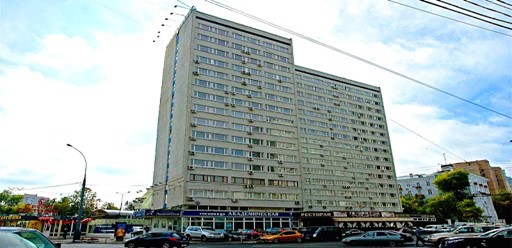

There was also a quaint little practice in all Soviet hotels, still surviving in some very rural Russian equivalents these days. This is the dezhurnaya. This was your “floor lady” (literally the term means “woman on duty”). She was always elderly with a desk near the elevators, lived on the floor, did your laundry for a small charge, and more or less kept order. She was also, of course, a direct channel to state security.
Each dezhurnaya would report on all movements of anybody residing on the floor (especially foreigners) and were always ready with a room key for an “inspection” while you were someplace else. For that matter, upon leaving I would be obliged to leave my room key at her desk on my floor, not at the counter downstairs.
During the almost three years of my intermittent stays, my dezhurnaya was a grandmother named Lyudmila (“Lyuda”). She was gruff, spoke no English, but warmed up to me because I occasionally brought gifts for her and her granddaughter from the beriozka.
These were stores run by the government open only to foreigners and in which only outside hard currency could be used. The stores provided goods not available to Soviet citizens (and it was a criminal offense for them to enter a beriozka). Exchange rates would be made up on the fly and your change would be whatever they had in the till at the time – deutschmarks, francs, lira, drachmas. However, all US dollars and coinage would always be retained “by the management.”
Toward the end of my hotel period, Lyuda would advise me when upcoming “building inspections” would be taking place; in case I might need to move something beforehand. It was useful to know about these visits, but I made a concerted effort never to have in my room anything they would find even remotely interesting. My cover was as a boring foreign academic.
During the later years of my time in Moscow I leased an apartment in the “academic neighborhood” nearby. What transpired from that apartment are subjects for later tales.
Either of the nearby two metro stations would provide an easy three stop train ride to the institute at which I was based. Each also had something noteworthy on the surface above.
One station was at Oktayabrskaya, a five-minute walk from the hotel.


Above the metro itself was probably the most famous single statue in the city, around which some of the more important public gatherings would take place over the years.
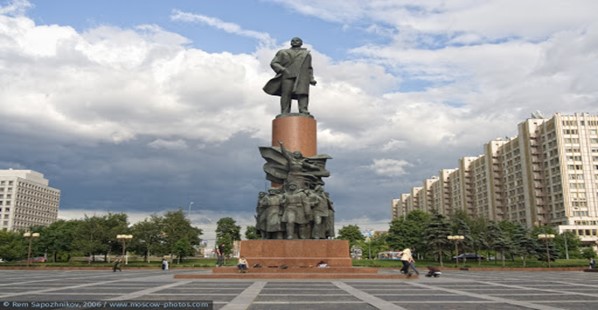

The other station was a ten-minute walk in another direction. That walk brought me to the Park Cultury station.
Now each of the older metro stations in inner Moscow are magnificent works of art with frescos, chandeliers, sculpture, and art everywhere. I used to spend Sunday mornings riding the cars, getting off at stations, and just admiring the artwork. Ended up an interesting cultural excursion for my KGB tails as well.
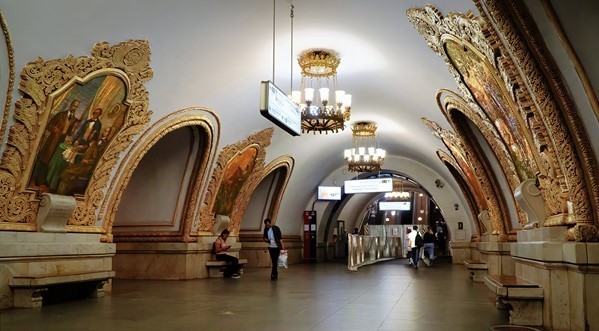

Topside over this station is a quite well-known Moscow outside site—Gorky Park.
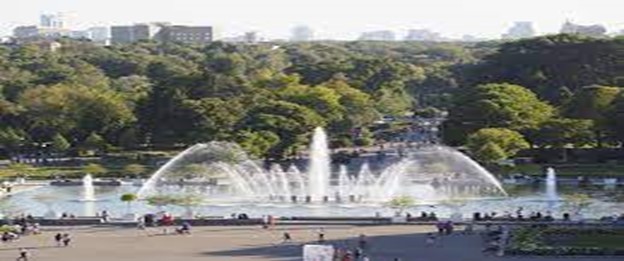

Each of these lines would bring me easily to my academic/scholarly office at the Academy’s Institute of Philosophy.
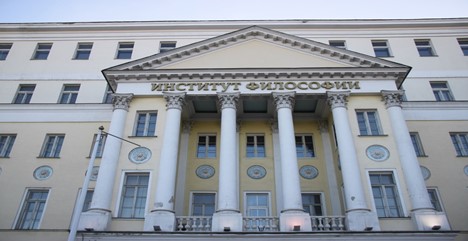

My academic notoriety was moving from political philosophy to energy analysis during this period. But the institute appointment was in the ideologically “safe” subject of Plato and other 2,500-year-old dead Greeks, the area in which I had already established a reputation.
Access to this institute was a prized entry for my “other employer.” It may have sounded like an esoteric think tank, but the Institute of Philosophy had a rather important role to play in the Soviet system. Its directors either moved from or to the Communist Party Central Committee, while the primary ideological interpreters where all located there.
It may say “Philosophy” on the entrance but this was as politically charged a place as you could find in Moscow at the time, outside of the Kremlin itself.
The Institute has been located in a beautiful example of pre-revolutionary Moscow nobility housing ever since it had been founded in the 1920s. This had originally been the central palace of Prince Golitsyn in the eighteenth century, converted to the Moscow residence of Catherine II, and then serving in the nineteenth century as home to the Moscow Conservatory, the Szaniawski Moscow Public University, and several academic centers and public service associations.
The third floor of the building has an impressive sight; mirroring similar ones witnessed at other Academy locations. Upon exiting the open shaft elevators, you are greeted by huge walls of framed photographs. All Institute scholars lost during the Great Patriotic War (World War II) are collected there. Colleagues told me that at least 70 percent of the greatest scholars of the time were killed between 1941 and 1945.
The Institute is also in some famous quarters. Next door is the largest fine art museum in Moscow, the Pushkin:
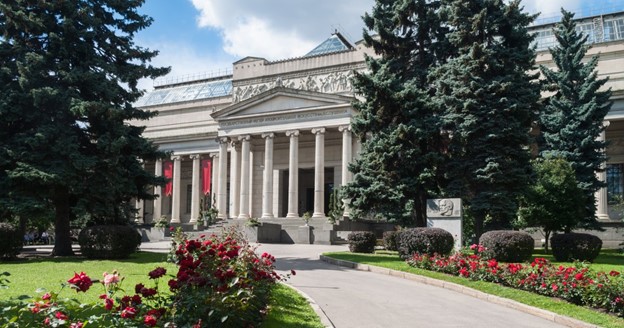

And virtually across the street during my years there was the Moskva Pool, the largest outside heated swimming pool in the world.
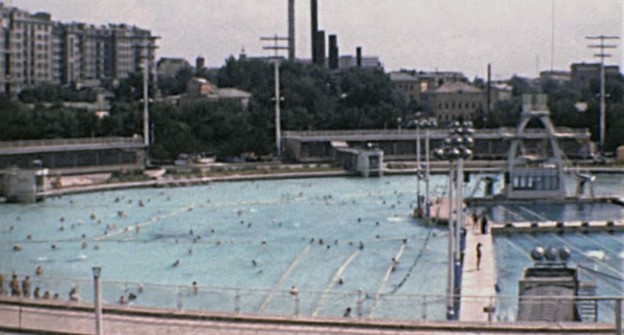

The pool had been built in the 1950s from the abandoned foundation of the never completed Palace of the Soviets. Stalin had begun the Palace in 1937 but construction was stopped with the onset of war.
Moskva Pool was closed in the 1990s. On its site now stands the magnificent Cathedral of Christ the Savior, completed in 1995.
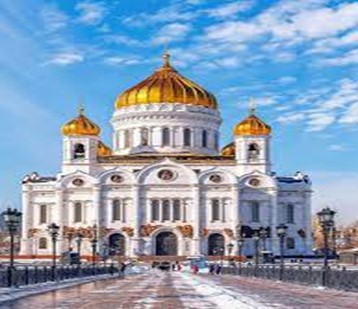

There is some poetic justice here. Stalin had razed the original cathedral to the ground to make way for his never finished Soviet Palace.
Now I certainly agree with the city government decision returning the cathedral to its rightful place. But I also admit remembering fondly the surrealistic experiences of a warm outside swim during snowstorms in 1980s Moscow.
Everything I did in Moscow needed to be done very carefully. As I discussed in the last Spy Tale (“Limiting the Flow of Illegals among the Butterflies of Niagara,” Classified Intelligence Brief, May 5, 2021), my position in Russia was as a NOC (having “no official cover.”) That meant I had no embassy protection should the other side decide to arrest me.
On the other hand, I was there under my own name, occupying a very overt position at the request of the Soviet Academy, doing in other words what I was supposed to be doing (at least overtly).
My primary NOC assignment unfolded over several years, centered on one person, and had resulted from a multiyear exercise in planning. While there would be ancillary tasks shoveled my way, all conduct had to follow “Moscow Rules.”
These assumed that one was always under surveillance, being watched, being listened to, having all communications interdicted. For the officers at the embassy (those having official cover) this meant (as contrasted to the drivel from Hollywood) never conducting espionage personally. For that, you recruited Soviets or other foreign nationals in country to act as agents or assets.
Official cover guys and gals spent their time developing and managing networks of agents/assets, while fashioning indirect ways of communicating with them. Given the fishbowl environment in which one operated in such hostile environs, the “Rules” mandated no direct personal contact with any agent.
There were emergency provisions for dead drops, as I described earlier (“Twenty Years after a Botched Dead Drop in Odessa,” Classified Intelligence Brief, April 21, 2021), but these were high risk.
The “Rules” guaranteed that everything done in Moscow would take much longer than just about anyplace else.
Having American intermediaries (businesspeople, tourists, reporters, academics, etc.) in town could provide some additional flexibility. But such individuals would have limited use since they were not trained and were likely under some sort of investigation from the time they went through customs at the airport. NOCs like me, therefore, were of more benefit. We were already living there.
But NOCS should never service existing agent networks or, worse still, initiate espionage. Either would be fatal to the assets involved and likely result in some prison time for the NOC. With one exception, I avoided a jail cell. That “adventure” is on a short list for approval and should be in an upcoming tale.
However, the primary reason for my structuring an elaborate legend (all quite true, by the way) was to exercise a separate standing operation, one that could only be exercised from the position I had secured at the Academy.
It is by far my most involved op. “Mother” has yet to allow a discussion of this but we are getting close for two reasons: (1) the statutory limitations have been met (i.e., the classified nature of the action is no longer enjoined); and (2) with the exception of yours truly and one other person on “our side,” everybody else seems to be dead. My actions may have contributed to two of the latter. You do not always have to pull the trigger to have such an effect.
I would hope this story line continues soon. In the interim, there are other episodes in Moscow and elsewhere that I can write about. Our next Spy Tale (May 19) will issue my annual recounting of an event that has occasioned more comment than anything I have ever written. It always appears near Memorial Day (because that is when it happened) and it is the most wrenching experience of my entire intel tenure.
On this occasion, however, and for the first time, I will be able to provide in the May 26 follow up tale some greater detail (and some personal closure). “Mother” has now permitted me to explain how we got even.


This is an installment of Classified Intelligence Brief, your guide to what’s really happening behind the headlines… and how to profit from it. Dr. Kent Moors served the United States for 30 years as one of the most highly decorated intelligence operatives alive today (including THREE Presidential commendations).
After moving through the inner circles of royalty, oligarchs, billionaires, and the uber-rich, he discovered some of the most important secrets regarding finance, geo-politics, and business. As a result, he built one of the most impressive rolodexes in the world. His insights and network of contacts took him from a Vietnam veteran to becoming one of the globe’s most sought after consultants, with clients including six of the largest energy companies and the United States government.
Now, Dr. Moors is sharing his proprietary research every week… knowledge filtered through his decades as an internationally recognized professor and scholar, intelligence operative, business consultant, investor, and geo-political “troubleshooter.” This publication is designed to give you an insider’s view of what is really happening on the geo-political stage.
You can sign up for FREE to Classified Intelligence Brief and begin receiving insights from Dr. Moors and his team immediately.
Just click here – https://classifiedintelligencebrief.com/






